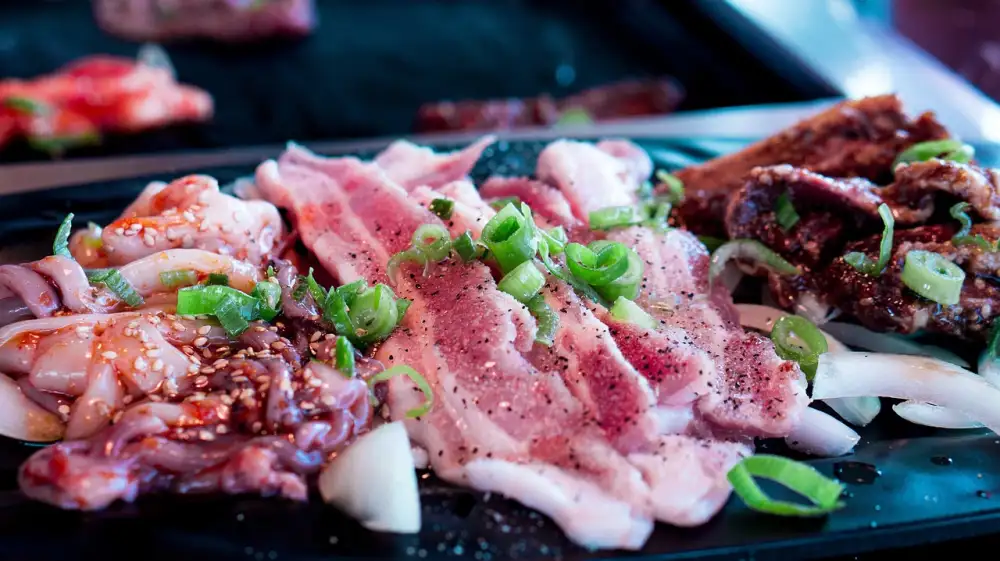Discover the Irresistible Flavors of Korean Beef: Recipes and Insights for Food Enthusiasts

- Introduction to Korean Beef
- History and Significance of Korean Beef
- Different Cuts of Korean Beef
- Traditional Korean Beef Recipes
- Modern Korean Beef Fusion Recipes
- Tips for Cooking Korean Beef at Home
- Where to Find Authentic Korean Beef
- Health Benefits of Korean Beef
- Pairing Korean Beef with Korean Side Dishes
- Conclusion: Embrace the Flavors of Korean Beef
Introduction to Korean Beef
Korean beef, also known as Hanwoo, is a culinary treasure that has captivated food enthusiasts around the world. Renowned for its exceptional flavor and tenderness, Korean beef offers a unique dining experience that is truly unforgettable. Whether you're a meat lover or simply curious about exploring new flavors, Korean beef is sure to delight your taste buds with its rich and savory profile. In this article, we will take you on a journey to discover the irresistible flavors of Korean beef, from its history and significance to traditional recipes and modern fusion creations. Get ready to embark on a culinary adventure like no other as we delve into the world of Korean beef excellence.
History and Significance of Korean Beef
Korean beef, also known as Hanwoo, has a rich history and holds great significance in Korean culture. Dating back to ancient times, cattle farming played a vital role in Korea's agricultural development. The importance of beef grew during the Joseon Dynasty when it became a symbol of wealth and power. Only the nobility had access to beef, making it a rare delicacy.
In modern times, Korean beef gained international recognition for its exceptional quality and flavor. The government implemented strict regulations to preserve the purity of the breed and maintain high standards. This dedication to quality has contributed to Korean beef's reputation as one of the finest meats in the world.
The significance of Korean beef extends beyond its culinary value. It represents tradition, heritage, and national pride for Koreans. It is often served during special occasions such as weddings or ancestral rituals, symbolizing prosperity and respect for ancestors.
The history and significance of Korean beef make it more than just a meal; it is a cultural experience that connects people to their roots.
Different Cuts of Korean Beef
Korean beef offers a wide variety of cuts, each with its own unique texture and flavor. The most popular cut is bulgogi, thinly sliced beef marinated in a sweet and savory sauce. Another favorite is galbi, beef short ribs that are marinated and grilled to perfection. For those who prefer a leaner option, there's chadolbaegi, thinly sliced brisket that is perfect for hot pot dishes. Other cuts include yangnyeom-gejang (marinated raw crab), jumulleok (beef skewers), and yukhoe (Korean-style beef tartare). With such a diverse range of cuts, there's something to satisfy every palate when it comes to Korean beef.
Traditional Korean Beef Recipes
Korean cuisine is known for its bold flavors and unique cooking techniques, and Korean beef dishes are no exception. Here are some traditional recipes that showcase the rich and savory taste of Korean beef.
1. Bulgogi: This classic dish features thinly sliced beef marinated in a mixture of soy sauce, sugar, garlic, sesame oil, and other seasonings. The meat is then grilled or stir-fried to perfection, resulting in tender and flavorful slices of beef.
2. Galbi: Galbi refers to grilled beef short ribs that have been marinated in a sauce made from soy sauce, garlic, ginger, sugar, and sesame oil. The marinade infuses the meat with a sweet and savory flavor that pairs perfectly with the smoky char from grilling.
3. Yukhoe: Yukhoe is a Korean-style beef tartare dish that is both elegant and delicious. It consists of finely chopped raw beef mixed with soy sauce, sesame oil, garlic, green onions, and other seasonings. The result is a melt-in-your-mouth texture with a complex blend of flavors.
4. Jangjorim: Jangjorim is a braised beef dish that is often served as a side dish or banchan in Korean cuisine. Thinly sliced beef is simmered in a flavorful broth made from soy sauce, garlic, ginger, and other aromatics until it becomes tender and infused with the rich flavors of the broth.
These traditional recipes highlight the artistry and depth of flavor that can be found in Korean beef dishes. Whether you're grilling up galbi or savoring the delicate flavors of yukhoe, these recipes are sure to satisfy any food enthusiast's cravings for authentic Korean cuisine.
Modern Korean Beef Fusion Recipes
Korean cuisine has evolved over the years, blending traditional flavors with international influences. Modern Korean beef fusion recipes showcase the versatility of this beloved ingredient. One such recipe is Korean Beef Tacos, where tender marinated beef is served in a warm tortilla with fresh vegetables and a tangy sauce. Another popular fusion dish is Korean Beef Bulgogi Pizza, combining the rich flavors of bulgogi with the crispy crust of a pizza. For those craving a spicy kick, try the Spicy Korean Beef Stir-Fry Noodles, where thin slices of beef are stir-fried with vegetables and spicy gochujang sauce. These modern fusion recipes offer a delightful twist to traditional Korean beef dishes, appealing to food enthusiasts who enjoy experimenting with different flavors and textures.
Tips for Cooking Korean Beef at Home
Cooking Korean beef at home can be a delightful and rewarding experience. Here are some tips to help you achieve the best results:
1. Marinate for Flavor: To infuse the meat with rich flavors, marinate it for at least 30 minutes or overnight. Use a mixture of soy sauce, garlic, ginger, sesame oil, and brown sugar for an authentic taste.
2. Proper Searing: Before cooking the beef, make sure to sear it on high heat to lock in the juices and create a caramelized crust. This will enhance the overall taste and texture of the dish.
3. Don't Overcook: Korean beef is best enjoyed when it is cooked to medium-rare or medium doneness. Overcooking can result in tough and dry meat, so keep a close eye on the cooking time.
4. Stir-Fry with Vegetables: For a quick and flavorful meal, stir-fry thin slices of Korean beef with colorful vegetables like bell peppers, onions, and carrots. The combination of tender beef and crunchy veggies will create a satisfying dish.
5. Try Grilling: Grilling Korean beef adds a smoky flavor that complements its natural richness. Use a charcoal or gas grill to cook thinly sliced beef cuts like bulgogi or galbi for an authentic barbecue experience.
6. Garnish with Sesame Seeds: Sprinkle toasted sesame seeds over your cooked Korean beef dishes for added texture and nutty flavor. It's a simple touch that elevates the overall presentation.
By following these tips, you can create delicious Korean beef dishes in your own kitchen and impress your family and friends with your culinary skills!
Where to Find Authentic Korean Beef
If you're eager to experience the authentic flavors of Korean beef, it's essential to know where to find the best quality meat. One option is to visit your local Korean grocery stores or Asian markets, as they often carry a variety of cuts of Korean beef. These establishments are known for sourcing their products directly from Korea, ensuring authenticity and freshness.
Another great option is to dine at Korean restaurants that specialize in serving traditional dishes. These establishments typically have partnerships with suppliers who provide them with high-quality Korean beef. By dining at these restaurants, you can enjoy expertly prepared dishes using authentic ingredients.
For those who prefer online shopping, there are several reputable websites that offer a wide range of Korean beef products. These websites work closely with trusted suppliers in Korea and ensure that the meat is properly packaged and shipped to maintain its quality.
To guarantee the authenticity of your purchase, look for labels or certifications indicating that the beef is imported from Korea. This will ensure that you are getting genuine Korean beef and not a substitute.
By knowing where to find authentic Korean beef, you can confidently embark on your culinary journey and savor the true flavors of this beloved cuisine.
Health Benefits of Korean Beef
Korean beef not only tantalizes the taste buds but also offers numerous health benefits. It is a great source of high-quality protein, essential for muscle growth and repair. Additionally, Korean beef is rich in vitamins and minerals such as iron, zinc, and B-vitamins, which are vital for maintaining overall health.
The marbling in Korean beef provides a natural source of healthy fats, including omega-3 fatty acids. These fats have been linked to reducing inflammation, improving brain function, and supporting heart health. Moreover, Korean beef is known to have a higher concentration of conjugated linoleic acid (CLA), which has been associated with weight loss and reducing the risk of certain diseases.
Furthermore, Korean beef contains antioxidants like selenium and vitamin E that help protect the body against oxidative stress and promote healthy skin. The presence of amino acids in Korean beef aids in collagen production, contributing to healthier joints and youthful-looking skin.
When choosing Korean beef, opt for grass-fed varieties as they tend to have higher levels of beneficial nutrients compared to grain-fed options. Incorporating this delicious meat into your diet can be a flavorful way to boost your nutritional intake while enjoying its many health advantages.
Indulge in the exquisite flavors of Korean beef while reaping its numerous health benefits – it's a win-win situation!
Pairing Korean Beef with Korean Side Dishes
One of the best ways to enhance the flavors of Korean beef is by pairing it with traditional Korean side dishes. These side dishes, known as "banchan," are an essential part of a Korean meal and complement the rich and savory taste of the beef.
Kimchi, a spicy fermented cabbage dish, is a popular choice to accompany Korean beef. Its tangy and crunchy texture adds a refreshing contrast to the meat. Another great option is Japchae, a stir-fried noodle dish made with vegetables and sweet potato noodles. Its sweet and savory flavor profile complements the beef perfectly.
For those who prefer something lighter, Kongnamul Muchim, or seasoned soybean sprouts, is an excellent choice. The crispness of the sprouts pairs well with the tender beef. Additionally, Gamja Jorim, braised potatoes in soy sauce, provides a comforting and hearty accompaniment to the beef.
Other banchan options include pickled radish (kkakdugi), cucumber salad (oi-muchim), and spinach side dish (sigeumchi namul). These side dishes not only add variety to your meal but also provide different textures and flavors that elevate your dining experience.
When pairing Korean beef with banchan, it's important to consider balance. The bold flavors of kimchi can be balanced with milder side dishes like bean sprouts or cucumber salad. Similarly, if you have chosen a spicier cut of beef, opting for milder banchan will help balance out the heat.
By pairing Korean beef with these delicious side dishes, you can create a harmonious culinary experience that showcases the diverse flavors of Korean cuisine. So next time you indulge in this delectable meat, don't forget to explore the world of banchan for an unforgettable dining experience!
Conclusion: Embrace the Flavors of Korean Beef
In conclusion, the rich and tantalizing flavors of Korean beef are a true delight for food enthusiasts. From its historical significance to the variety of cuts and traditional recipes, Korean beef offers a unique culinary experience. Whether you prefer the authentic taste or enjoy experimenting with fusion recipes, there is something for everyone to savor.
Cooking Korean beef at home can be an exciting adventure, and with a few tips, you can create mouthwatering dishes that rival those found in restaurants. And speaking of restaurants, if you're looking for authentic Korean beef, there are numerous establishments that specialize in serving this delectable meat.
Not only does Korean beef offer incredible taste, but it also provides health benefits. It is packed with essential nutrients and proteins that contribute to overall well-being. Additionally, pairing Korean beef with traditional side dishes enhances the dining experience and creates a harmonious balance of flavors.
So why not embrace the flavors of Korean beef? Whether you're a seasoned food enthusiast or just starting your culinary journey, exploring the world of Korean beef will undoubtedly leave you craving more. So grab your apron, head to your nearest grocery store or restaurant specializing in Korean cuisine, and let your taste buds embark on an unforgettable adventure.
Published: 14. 11. 2023
Category: Food



